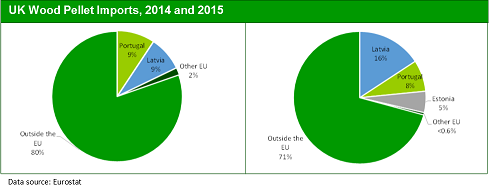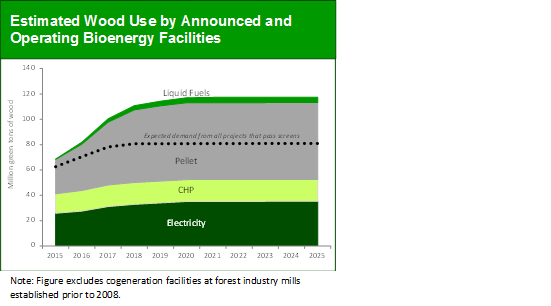This post includes an excerpt from the bioenergy research published in the Q1 2016 Forisk Research Quarterly (FRQ) Publication.
U.S. wood pellet exports continue to grow, albeit at a slower pace.
U.S. wood pellet exports continued to increase in 2015, with a total of 4.6 million metric tons exported. Though this represents an increase of 12.8% over 2014 volumes, the growth rate of exports is slowing. For comparison, U.S. wood pellet exports rose 40.7% between 2013 and 2014. Exports grew at a compound annual growth rate of 34.1% from 2012 through 2015.
The market share of exported U.S. wood pellets continues to consolidate. The United Kingdom imported 84%, 3.8 million metric tons, of all U.S. wood pellet exports in 2015, an increase of over 29% from 2014. U.S. wood pellet exports to Belgium also increased 29% in 2015 to over 600 thousand metric tons. These two countries alone accounted for 97% of all U.S. wood pellet exports in 2015.
Wood pellet demand in the UK is increasingly sourced from within the EU, specifically the Baltic States.
The largest importer of wood pellets globally, the UK sources most of its wood pellet imports from countries outside of the EU. As a result of sustained strength in the U.S. dollar, however, the percentage of market share between wood pellet trade within and outside the 28-country bloc has been shifting. In 2014, 20% of the country’s 4.7 million metric tons of wood pellet imports originated within the bloc. Through October 2015, approximately 30% of the country’s 5.4 million metric tons of imports were from within the EU. This increased demand in the UK is being met with wood pellet volumes from Baltic States—specifically, Latvia and Estonia.
The wood bioenergy outlook remains stable for the U.S.; any meaningful growth, if realized, will occur in the next five years.
The figure below details estimated wood use associated with bioenergy, by project type, in the United States through 2025. The “estimated demand from all projects,” as represented by the dotted line, reflects the application of Forisk’s screening of all 433 operating and announced projects tracked in Forisk’s wood bioenergy database as of February 3, 2016. This is up from 431 projects as of October 26, 2015. These projects represent potential wood use of 119.2 million tons per year by 2025. Based on Forisk’s analysis, 297 projects—representing potential wood use of 80.9 million tons per year—pass basic viability screening.
To download the most recent Wood Bioenergy Summary, click here.
Forisk Analyst/Project manager Andrew Copley supported the research for this blog post.



Leave a Reply